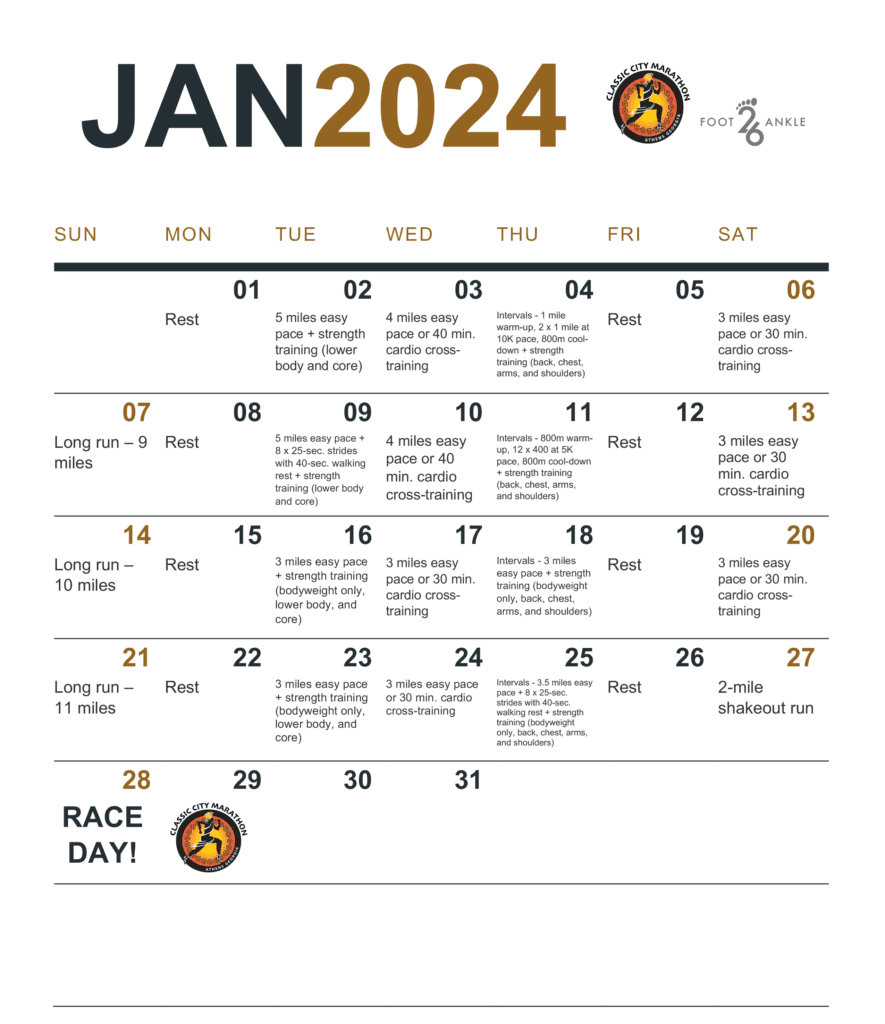Completing a half marathon is an ambitious goal that requires dedication, discipline, and proper preparation. While crossing the finish line after 13.1 miles brings an immense sense of accomplishment, inadequate training often leads to discouraging injuries that disrupt your program. As a podiatrist, I commonly treat patients for plantar fasciitis, stress fractures, Achilles tendonitis, shin splints, knee pain, IT band syndrome, and more due to increasing mileage too drastically. Outlined below is a comprehensive 12-week beginner half marathon training plan to gradually build your fitness while minimizing injury risk so you can achieve your goal.
Getting Started: Building an Aerobic Base
If you are new to running, you should consider investing 2-4 months before the training program to build an aerobic base with 30-45 minutes of easy jogging 3 days per week. This initial period allows your bones, joints, muscles, tendons, and ligaments to adapt to the repetitive impact of running prior to higher mileage. Go at a conversational pace where you can comfortably chat. Proper recovery with rest days, foam rolling, dynamic stretches, anti-inflammatory foods and medicine, and 8+ hours of sleep will help condition your body for the upcoming training.
Gearing Up to Prevent Injuries
Properly fitted running shoes provide shock absorption and support based on your foot type and specific gait pattern. It would be best if you considered visiting a specialty shoe store or a podiatrist focusing on sports medicine for an evaluation. Replacing shoes every 300-500 miles as cushioning breaks down over time will help you avoid injuries and stay on your training plan. Moisture-wicking socks help prevent blisters and chafing by keeping feet dry. Apply petroleum jelly or anti-chafe balms to high-friction areas like armpits, inner thighs, and below the bra line. Mild over-the-counter anti-inflammatories like ibuprofen can be taken 30-60 minutes before running to reduce pain and swelling during and after exercise. Compression socks, KT tape, and orthotic shoe inserts also aid many runners.

Overview of a 12-Week Beginner Half Marathon Training Schedule, this comprehensive 12-week training program incrementally builds your endurance and stamina using a blend of easy runs, long runs, speedwork, cross-training, and rest. Your body needs to gradually adapt to increasing mileage. The long run is the cornerstone each week, preparing you mentally and physically to run 13.1 miles on race day. Speedwork develops efficiency and foot speed while easy mileage builds aerobic capacity. Two rest days allow muscles time to recover and repair between workouts.
Proper fueling and hydration throughout the week provide energy for training and help muscles heal.



Key Components of a Half Marathon Training Plan
● Easy Runs – Done at a conversational pace, these 3-5 mile runs increase aerobic fitness. Build total weekly mileage by no more than 10%.
● Long Runs – The most critical workout, long runs start at 6 miles, and peak at 12 miles before tapering. Simulate race fueling. Increase distance by 1-2 miles weekly.
● Speedwork – Tempo runs, intervals, hill repeats and boost speed while completing easier mileage.
● Strength Training – 2-3x/week. Builds muscle to support joints, improves form, and prevents injury. Target core, hips, glutes, quads.
● Recovery – Rest days, stretching, foam rolling, muscle massage, ice baths. Fuel properly with carbs, protein, and electrolytes.
● Gear – Replace running shoes around 300-500 miles. Wear moisture-wicking socks. Use anti-chafe products.
● Listen to your body – Adjust training if experiencing pain or excessive fatigue. Prevention is key.
Incorporating Cross-Training
Cross-training 1-2 days per week with cycling, swimming, elliptical machines, etc allows your muscles a break from the impact of running while still building cardiovascular fitness. This allows you to maintain overall training volume while decreasing injury risk from constantly pounding the pavement. But don’t completely replace running workouts with cross-training or you won’t condition your body for the specific demands of running long distances.

Warming Up and Cooling Down
Properly warm up your muscles before each run with 5-10 minutes of walking or slow jogging, then do some dynamic stretches for the major muscle groups. After the workout, cool down for 5-10 minutes to decrease soreness by keeping blood flowing. Static stretching is best saved for after the cool-down. Massage, foam rolling, an ice bath, or compression socks all help muscles recover after hard efforts.

Listen to Your Body
Pay close attention to signals from your body during training. Minor aches and pains are expected, but sharp and sudden pain often indicates an injury that requires rest to heal properly. Immediately stop running if you feel shooting pain. Also adjust your program if you experience chronic fatigue, lack of motivation, or poor sleep. These can be red flags that you are overtraining. It is better to take a few days off than be sidelined for weeks or months with a preventable injury. Patience and gradual progress are key.

In Conclusion
Preparing for a half marathon is a challenging yet gratifying process. Following a properly designed training plan that builds your fitness incrementally is vital for staying healthy and reaching the finish line. Resist the urge to ramp up mileage or intensity too quickly. Employ cross-training, strength training, adequate recovery, and smart gear to prevent issues. Listen to your body and adjust the program if needed. Stay motivated knowing your hard work will pay off when you triumphantly cross that finish line!



